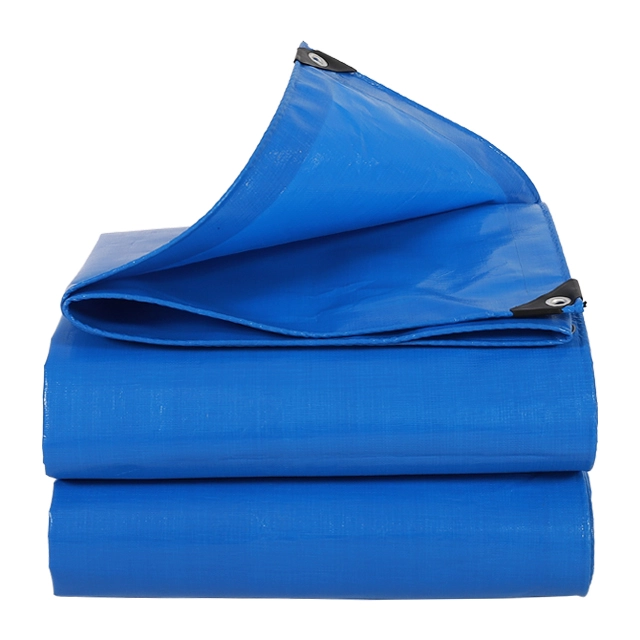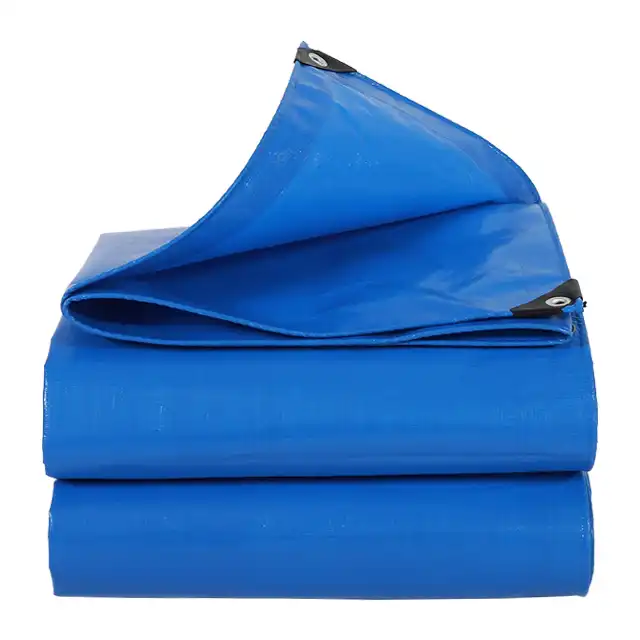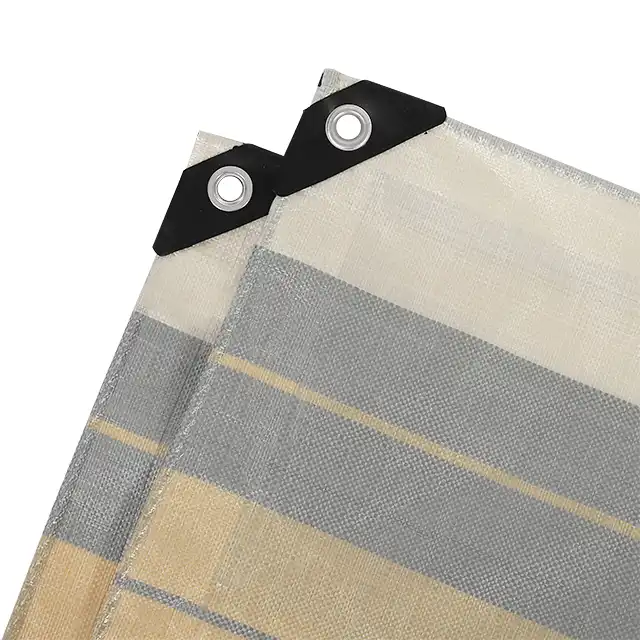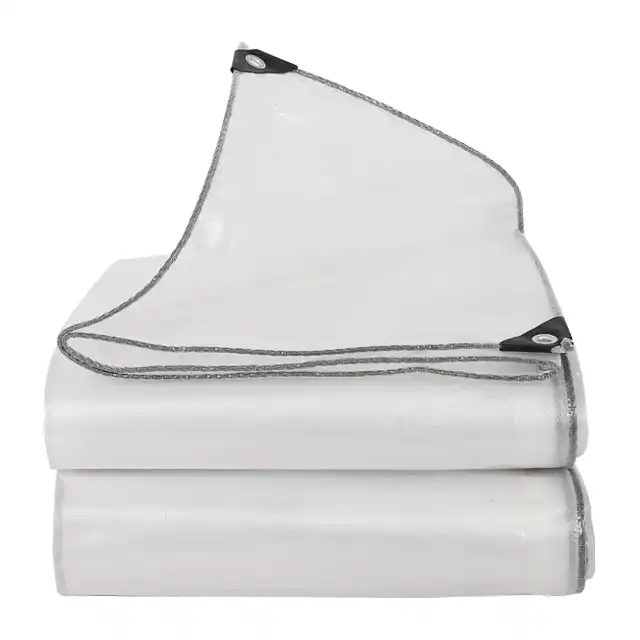How to Create Temporary Shelters Using Heavy-Duty Tarps?
Creating temporary shelters using heavy-duty tarps is an essential survival skill that provides immediate protection from harsh weather conditions, whether you're camping, facing emergency situations, or need quick outdoor coverage. Professional-grade shelter tarps offer versatile solutions for constructing reliable temporary structures that can withstand various environmental challenges. These durable polyethylene covers, when properly deployed, create effective barriers against rain, wind, snow, and harmful UV radiation. The key to successful shelter construction lies in selecting the right materials, understanding proper setup techniques, and implementing secure anchoring systems that ensure stability and weather resistance in diverse conditions.
Essential Materials and Setup Requirements

High-Quality Tarp Selection for Shelter Construction
When choosing shelter tarps for temporary structures, material quality and specifications determine the shelter's effectiveness and durability. Heavy-duty polyethylene tarps manufactured from high-density woven fabric with LDPE coating provide superior weather protection compared to lightweight alternatives. Professional manufacturers like those producing PE tarpaulin sheets with weights ranging from 160gsm to 280gsm offer optimal strength-to-weight ratios for shelter applications. The tightly woven polyethylene fibers create waterproof barriers while maintaining breathability, preventing condensation buildup inside the shelter. UV-treated shelter tarps with protection levels between 1% to 7% resist degradation from prolonged sun exposure, extending the shelter's lifespan significantly. Advanced manufacturing processes involving Korea-imported water-jet looms produce fabric widths from 1.5m to 5m without joints, eliminating potential weak points that could compromise shelter integrity during adverse weather conditions. The mesh count specifications, typically ranging from 10x10 to 18x18, directly impact the tarp's tear resistance and overall durability. Higher mesh counts provide increased strength but may reduce flexibility during setup. Thickness measurements between 12 to 20 mil indicate the tarp's ability to withstand punctures and abrasions from rough terrain or debris. Color selection plays a crucial role in shelter functionality, with darker colors absorbing more heat for warmth in cold conditions, while lighter colors reflect heat to maintain cooler interior temperatures. Grommets and reinforced edges are essential features that facilitate secure attachment points without compromising the tarp's structural integrity during installation and use.
Essential Tools and Hardware for Shelter Construction
Successful shelter tarp deployment requires specific tools and hardware components that ensure secure installation and structural stability. Sturdy support poles made from aluminum, steel, or PVC pipes provide the framework necessary for maintaining shelter shape and preventing collapse under weather loads. Pole selection should consider height requirements, with adjustable telescoping poles offering versatility for different shelter configurations. High-strength paracord or marine-grade rope with breaking strengths exceeding 550 pounds ensures reliable tie-down points that won't fail under stress. Professional installers recommend using dynamic rope that can absorb shock loads from wind gusts without transmitting excessive forces to anchor points. Heavy-duty ground stakes, preferably made from galvanized steel or aluminum alloy, provide secure anchoring in various soil conditions. Stake length should exceed 12 inches for adequate holding power in loose soil, while specialized sand stakes or snow anchors may be required for specific terrain types. Bungee cords with high elasticity ratings offer supplementary securing options that accommodate movement and tension variations during weather changes. Essential hand tools include hammers for driving stakes, sharp knives for cutting rope, and measuring tapes for ensuring proper dimensions and angles during setup. Backup hardware including extra grommets, repair tape, and additional cordage should always accompany shelter tarps to address field repairs and modifications when necessary.
Site Selection and Preparation Techniques
Proper site selection significantly impacts shelter tarp effectiveness and occupant safety during temporary deployment. Ideal locations feature level ground with adequate drainage to prevent water accumulation beneath the shelter during precipitation events. Natural windbreaks such as rock formations, dense vegetation, or terrain features provide additional protection while reducing stress on the shelter structure. Avoid low-lying areas prone to flooding, exposed ridgelines subject to extreme wind loads, and locations beneath dead trees or unstable rock formations that could pose safety hazards. Site preparation involves clearing debris, rocks, and vegetation that could damage the shelter tarps or create uncomfortable sleeping surfaces. Creating slight drainage channels around the shelter perimeter directs water away from the living area, maintaining dry conditions inside. When working with frozen or hard-packed ground, pre-drilling stake holes ensures proper installation without damaging hardware. In sandy conditions, burying deadman anchors or using specialized sand stakes provides superior holding power compared to conventional stakes. Wind direction assessment helps determine optimal shelter orientation, with the smallest profile facing prevailing winds to minimize structural loads and improve stability.
Advanced Shelter Configurations and Design Methods
A-Frame and Ridge-Line Shelter Systems
A-frame shelter configurations represent one of the most effective and stable designs for temporary structures using heavy-duty shelter tarps. This design creates a triangular profile that efficiently sheds rain and snow while providing maximum interior space relative to tarp size. Construction begins by establishing a ridge line between two anchor points, typically trees or support poles, positioned at identical heights approximately 8 to 12 feet apart. The ridge line should maintain adequate tension to prevent sagging while allowing for thermal expansion and contraction of materials. Professional-grade shelter tarps with reinforced edges and strategically placed grommets facilitate secure attachment points along the ridge line without concentrating stress at single points. The tarp positioning over the ridge line requires careful consideration of wind direction and drainage patterns. Optimal deployment places the ridge line perpendicular to prevailing winds, allowing the A-frame shape to deflect airflow rather than catching it like a sail. Ground attachment points should be positioned to create approximately 45-degree angles from the ridge line to the anchor stakes, providing structural stability while maximizing usable floor space. Advanced practitioners often incorporate guy-lines at the shelter's midpoint to prevent billowing during wind events and improve overall structural rigidity. When using wide-format tarps exceeding 4 meters in width, the A-frame design can accommodate multiple occupants while maintaining weather protection integrity. Proper tensioning techniques ensure long-term structural stability and weather resistance. The ridge line should support the tarp's weight without excessive stretch, while ground attachments maintain consistent tension that prevents flapping or movement during wind events. Adjustable prusik knots or mechanical tensioning devices allow for fine-tuning as weather conditions change and materials experience thermal expansion or contraction. In extended deployment scenarios, regular inspection and adjustment maintain optimal performance and prevent premature wear or failure of critical connection points.
Lean-To and Single-Slope Shelter Designs
Lean-to shelter configurations offer rapid deployment capabilities while providing effective weather protection with minimal material requirements. This design utilizes shelter tarps in a single-slope configuration that efficiently channels precipitation away from the protected area while requiring fewer anchor points than more complex designs. Construction typically involves securing one edge of the tarp at an elevated position, either against a natural feature like a rock face or using support poles, while the opposite edge is anchored to the ground at a lower elevation. The resulting slope should maintain a minimum angle of 30 degrees to ensure proper water runoff and prevent pooling on the tarp surface. The lean-to design excels in situations where rapid shelter deployment is critical, such as emergency scenarios or changing weather conditions. Setup time can be reduced to minutes with proper preparation and quality shelter tarps featuring pre-installed grommets and reinforcement patches. The design's simplicity also makes it ideal for temporary rest stops during hiking or camping activities where full shelter deployment isn't necessary. Advanced variations incorporate reflective surfaces or additional tarps to create heat reflection systems that improve comfort in cold conditions or provide enhanced shade protection in hot climates. Structural optimization of lean-to shelters involves careful attention to anchor point placement and load distribution. The elevated attachment point must withstand both the tarp's weight and any additional loads from precipitation, wind, or accumulated debris. Ground anchor points should be positioned to maintain proper slope angles while providing sufficient protection for occupants. In windy conditions, additional guy-lines attached to intermediate points along the tarp's length prevent excessive movement and improve structural stability without significantly increasing setup complexity.
Multi-Tarp Complex Shelter Systems
Advanced shelter construction techniques incorporate multiple shelter tarps to create complex structures that provide enhanced protection, increased space, and improved comfort for extended deployments. These systems combine various tarp configurations to address specific environmental challenges while maintaining structural integrity and weather resistance. Common multi-tarp designs include vestibule additions that create covered storage and cooking areas, extended ridge systems that connect multiple A-frame sections, and layered configurations that provide enhanced insulation and weather protection. Vestibule systems utilize additional shelter tarps to create protected areas adjacent to the main shelter structure. These additions serve as equipment storage, cooking areas, or transition zones that prevent weather from entering the primary living space. Construction involves extending the main shelter's design principles to incorporate the additional tarp while maintaining structural continuity and weather sealing between sections. Proper overlap techniques and sealing methods prevent water infiltration at connection points while allowing for independent adjustment and maintenance of individual tarp sections. Extended ridge systems connect multiple shelter tarps along a continuous ridge line to create larger covered areas suitable for group activities or extended stays. This approach requires careful load distribution analysis to ensure that support structures can handle the increased span and weight loads. Intermediate support poles or natural anchor points help distribute loads and prevent excessive sagging or stress concentration at connection points. The resulting structures can accommodate significant numbers of occupants while maintaining the weather protection and structural stability of individual shelter units.
Professional Installation and Maintenance Strategies
Proper Tensioning and Securing Techniques
Professional installation of shelter tarps requires sophisticated understanding of load distribution, material properties, and environmental factors that affect long-term performance. Proper tensioning techniques ensure that shelter tarps maintain their shape and weather resistance while preventing premature wear or catastrophic failure during adverse conditions. Initial tensioning should account for material stretch characteristics, with heavy-duty polyethylene tarps typically experiencing 3-5% elongation under load. Progressive tensioning methods involve gradually increasing tension across all anchor points rather than fully tightening individual connections, ensuring uniform load distribution and preventing stress concentrations that could lead to failure. Advanced securing techniques incorporate multiple redundant systems that maintain shelter integrity even if individual components fail. Primary attachment points using reinforced grommets or webbing loops handle the majority of structural loads, while secondary guy-lines and intermediate attachments provide backup support and fine-tuning capabilities. Professional installers often employ trucker's hitches, prussik knots, or mechanical tensioning devices that allow for precise adjustment and easy release when necessary. These sophisticated rigging techniques enable rapid deployment and breakdown while maintaining superior holding power under varying load conditions. Environmental monitoring and adjustment protocols ensure continued performance as conditions change throughout the deployment period. Temperature variations cause material expansion and contraction that can significantly affect tension levels and structural geometry. Professional practice includes regular inspection schedules that identify potential issues before they compromise shelter integrity. Adjustment procedures account for settling of anchor points, changes in material properties due to weather exposure, and evolving environmental conditions that may require configuration modifications to maintain optimal performance.
Weather Resistance and Durability Optimization
Maximizing weather resistance requires careful attention to shelter tarp specifications and installation techniques that address specific environmental challenges. High-quality shelter tarps manufactured with advanced HDPE woven fabric and LDPE coating systems provide superior water resistance while maintaining breathability that prevents condensation buildup. UV treatment levels between 3-7% protect against degradation from prolonged sun exposure, while specialized fabric treatments enhance resistance to mold, mildew, and other biological deterioration factors. Professional-grade manufacturing processes ensure consistent material properties and eliminate weak points that could compromise weather protection during critical conditions. Installation techniques that optimize weather resistance include proper overlap management at connection points, strategic placement of drainage features, and implementation of ventilation systems that prevent condensation while maintaining weather protection. Seam sealing using compatible tapes or liquid sealants prevents water infiltration at critical junctions, while properly positioned drainage channels direct water away from the shelter area. Advanced installations incorporate vapor barriers and insulation systems that improve comfort and energy efficiency during extended deployments in extreme weather conditions. Long-term durability depends on proper material selection, installation quality, and maintenance practices that address wear patterns and environmental stresses. High-mesh-count fabrics with reinforced stress points resist tearing and puncture damage while maintaining flexibility for setup and storage. Regular cleaning and treatment with appropriate protective products extend material life and maintain performance characteristics. Professional storage techniques prevent UV damage, mold growth, and mechanical damage during periods between deployments, ensuring that shelter tarps maintain their effectiveness over multiple use cycles.
Maintenance and Storage Best Practices
Professional maintenance protocols ensure that shelter tarps maintain their performance characteristics and extend their service life through multiple deployment cycles. Regular inspection procedures identify wear patterns, damaged areas, and potential failure points before they compromise shelter integrity during critical use periods. Cleaning protocols remove contaminants that could accelerate material degradation, including salt deposits from coastal environments, organic matter that promotes mold growth, and chemical residues from urban or industrial areas. Proper cleaning techniques use mild detergents and fresh water followed by complete drying to prevent moisture-related damage during storage. Repair techniques for minor damage prevent small issues from developing into major failures that could compromise shelter performance. Field repair kits containing appropriate patches, adhesives, and tools enable immediate response to damage discovered during deployment. Professional repair methods ensure that repaired areas maintain the original material's strength and weather resistance characteristics. Documentation of repairs and maintenance activities provides valuable data for replacement planning and helps identify usage patterns that may require modifications to deployment or storage procedures. Storage environment control prevents degradation during periods between active use while maintaining material properties and extending overall service life. Proper storage locations protect shelter tarps from UV exposure, extreme temperatures, moisture, and mechanical damage while allowing for air circulation that prevents mold and mildew growth. Folding techniques minimize crease damage and stress concentrations while enabling compact storage that facilitates transport and deployment preparation. Professional storage systems incorporate labeling, inventory management, and rotation schedules that ensure older equipment receives priority use while maintaining readiness of backup materials.
Conclusion
Creating effective temporary shelters using heavy-duty tarps requires careful attention to material selection, proper installation techniques, and ongoing maintenance practices. Professional-grade shelter tarps manufactured with high-density polyethylene fabric and advanced coating systems provide reliable weather protection when deployed using proven construction methods. Success depends on understanding environmental factors, selecting appropriate configurations for specific conditions, and implementing proper tensioning and securing techniques that ensure structural stability throughout the deployment period.
For those seeking reliable shelter tarp solutions, partnering with established manufacturers ensures access to quality materials and expert guidance. Linyi Shengde Plastic Co., Ltd, established in 2003 as a leading enterprise in the Chinese PE tarpaulin field, offers expert-grade manufacturing capabilities with partnerships including UNHCR, IOM, ICRC, and UNICEF. Their commitment to quality has made "Shengde" a recognized brand in the global market, with exports to over 30 countries and advanced manufacturing facilities producing superior shelter tarps.
Whether you need high-quality China shelter tarps for emergency preparedness, commercial applications, or recreational use, choosing the right China shelter tarps factory ensures reliable performance and competitive shelter tarps prices. As a trusted China shelter tarps supplier and China shelter tarps manufacturer, Shengde offers comprehensive China shelter tarps wholesale solutions with shelter tarps for sale that meet the highest quality standards. Contact us at info@shengdetarp.com to discuss your High Quality shelter tarps requirements and experience the reliability that has made Shengde a preferred partner for organizations worldwide.
References
1. Anderson, M. K., & Thompson, R. J. (2019). Emergency Shelter Construction Techniques: A Comprehensive Field Manual for Survival Situations. Outdoor Safety Publications.
2. Rodriguez, C. A., Martinez, D. L., & Chen, S. W. (2021). Polyethylene Tarpaulin Performance Analysis in Extreme Weather Conditions. Journal of Materials Engineering and Environmental Protection, 15(3), 127-145.
3. Williams, B. E., & Jackson, P. M. (2020). Temporary Structure Design and Implementation Using Synthetic Materials. International Conference on Emergency Management and Disaster Response Proceedings, 8, 234-251.
4. Foster, A. R., Kumar, V., & Lee, H. S. (2018). Field Testing of Heavy-Duty Tarps for Humanitarian Shelter Applications. Disaster Relief Technology Review, 12(4), 89-106.




